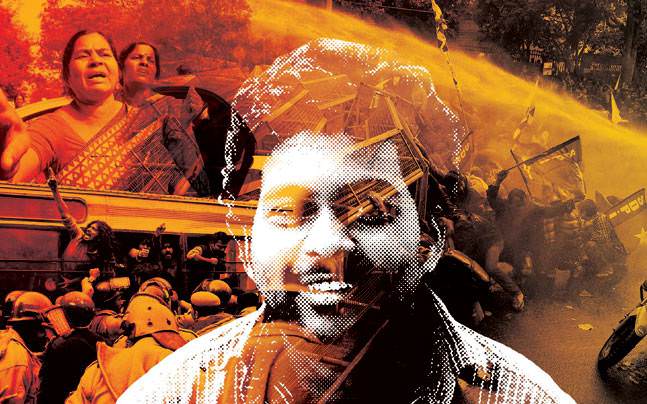I don’t remember the moment news of Rohith’s death crashed over in great waves. I remember stinging guilt at the months of inaction while Rohith and his friends braved an onslaught of casteist abuse at the University of Hyderabad. I remember tears of agony at the helplessness.
A lot has changed in a year. Some of us have made careers out of discovering caste, writing books and articles on Rohith, situating caste in Dalit bodies or “researching” Dalit politics. Others have clung onto power despite cases slapped on them and clear proof of their complicity in Rohith’s death. Still others have focused on mutilating his caste identity, as if a few documents can erase the power of his words or legacy.
But the year has also witnessed unprecedented fight back. Sunkanna Velpula standing up to the vice-chanellor at convocation, the strikes and marches in Hyderabad, the joint action committee’s resistance and the spate of anti-caste work in universities across the country.
None of this is new. The death of Dalit Bahujan Adivasi students at Indian universities has been chronicled for at least four decades but hasn’t managed to wake up the “mainstream” consciousness or those who govern these institutions – predominantly dominant caste folks whose commitment to social justice ends at the Phd thesis defence table.
Before Rohith, there was Balmukund Bharti, a student at Delhi’s All India Institute of Medical Sciences who was hounded by teachers and students for months and finally killed himself. There was Chuni Kotal who had made her entire community proud by becoming the first female graduate but took her life after shame and humiliation at the hands of her Bengali dominant caste teachers. In every case, those accused of pushing these bright students to die flourished as respected academics.
This isn’t an accident. As Rohith repeatedly explained in his facebook posts and writings, our universities are primarily designed to accrue and exploit caste capital, not undo it. This is why our syllabi is so lopsided, our “popular” history erases women, Dalits, Bahujans and adivasis and why an exclusionist, violent notion such as “merit” continues to be used as a handle to push Dalit students out of universities.
As Nidhin Shobhana points out in this fantastic Roundtable India piece, even India’s so-called most progressive university, JNU, has had a casteist existence. The university willfully continues to undermine reservations, faculty recruitment of SC/ST/OBC people is low and any visibility is the preserve of the dominant.
Rohith, however, has forged together a powerful campaign spanning across universities that is resisting casteism. At JNU, for example, the Birsa Ambedkar Phule Students Association has exposed how viva marks are used to exclude Dalit students from admission and how the supposedly progressive student’s union uses thinly veiled casteism to keep Dalit Bahujan students away from power. Similar movements at various parts of the country are trying to fundamentally change the character of our elite institutions for the better.
But despite the outpouring of sympathy for Rohith, there has been little “mainstream” support for the movement, other than omnipresent solidarity. Dominant castes continue to behave like they’re casteless and that the lives and struggles of Dalit people are research proposals for them to dissect and discuss.
At the core of this behavior is a refusal to accept one’s own caste privilege and admit that casteism is systemic and resides in each one of us. This trait makes dominant castes use “identity politics” as a slur – as if their blanket domination of academics isn’t based on identity, and divert any discussion of caste bias to a referendum on reservation.
It is no accident that some of the worst attacks on Dalit people happens in the pursuit of education and consequent dignity.
“It is your claim to equality which hurts them,” Ambedkar said. “We cannot forgo our right and opportunities to reap the benefit of the highest education to the fullest extent…without education their existence is not safe,” Ambedkar said.
But despite the odds, a movement is building. When JNU authorities last month tried to push through anti-Dalit admission measures that would increase discretionary marking, Bapsa and other groups protested and managed to bring the issue to the forefront. Many of them had to pay for this bravado with suspension notices that jeopardized their careers and threw them out of hostels in the December cold. Again, the attack on education and again, the eerie similarity to Rohith. When I visited JNU during a public meeting in December, one of the suspended students told me, “There are few people only at the meetings. It is as if they’re waiting for a student to die.”
They are right. Many of us, even the well-meaning ones, wait for a death to express our solidarity and outrage, no matter how ridiculous and pointless it is then. But caste is all around us, in the everyday.
When Dalit students are mocked in class, made to sit separately, failed in tests, ridiculed in interviews and their spirits crushed, it is upto the rest of the student body to rise up in anger. Extend a helping hand, educate yourself, try and let go of biases and let Dalit people take centrestage about their lives and experiences.
As 11 more people wait to fight an uncertain battle against a formidable enemy and an enmeshed caste system, we owe it to Rohith Vemula to stop any more Dalit dead bodies. The dreams of too many talented young people has been sacrificed at the altar of Manu. On Rohith’s Shahadat Divas, let’s pledge that there will no more. Only then will some of the guilt and agony be assuaged.
Featured Image Credit: Photo Illustration by Saurabh Singh via IndiaToday.in
About the author(s)
Xavier's. Bose Institute. ACJ. Works at Hindustan Times. Physics+Journalism make for a bad curry. Bengal fan. Mamata fanatic.




